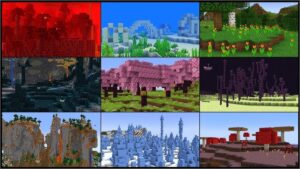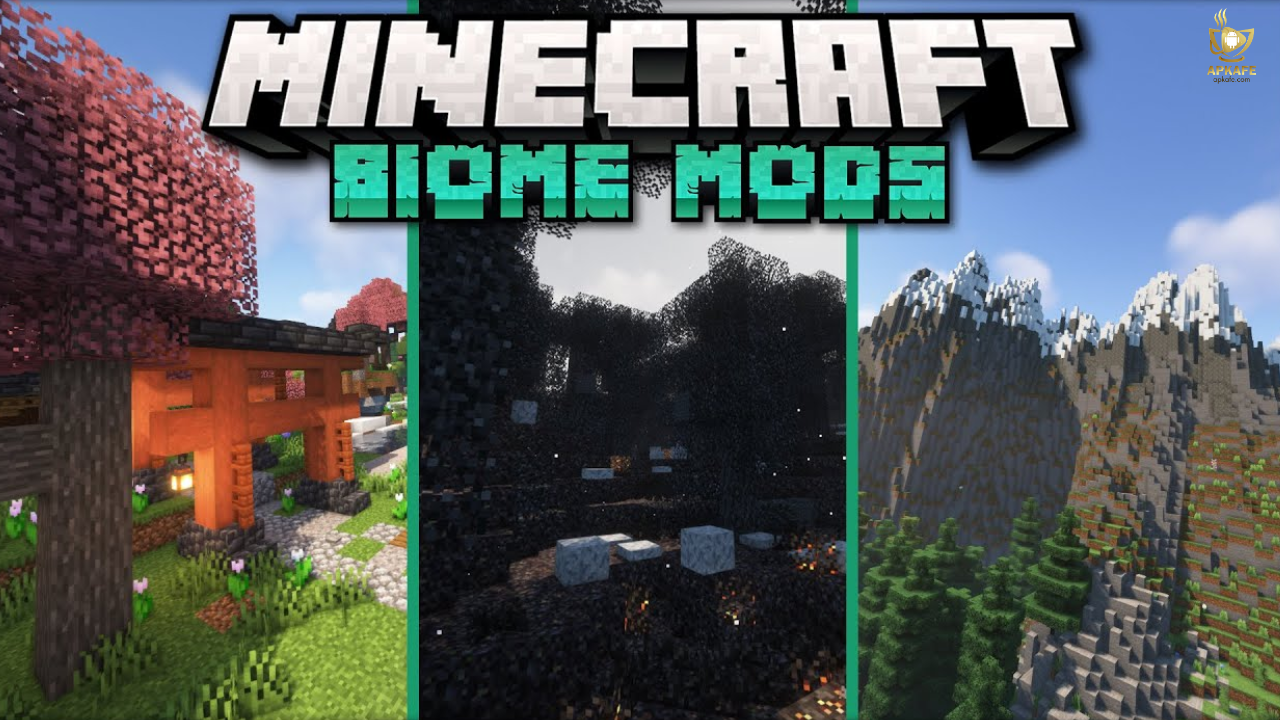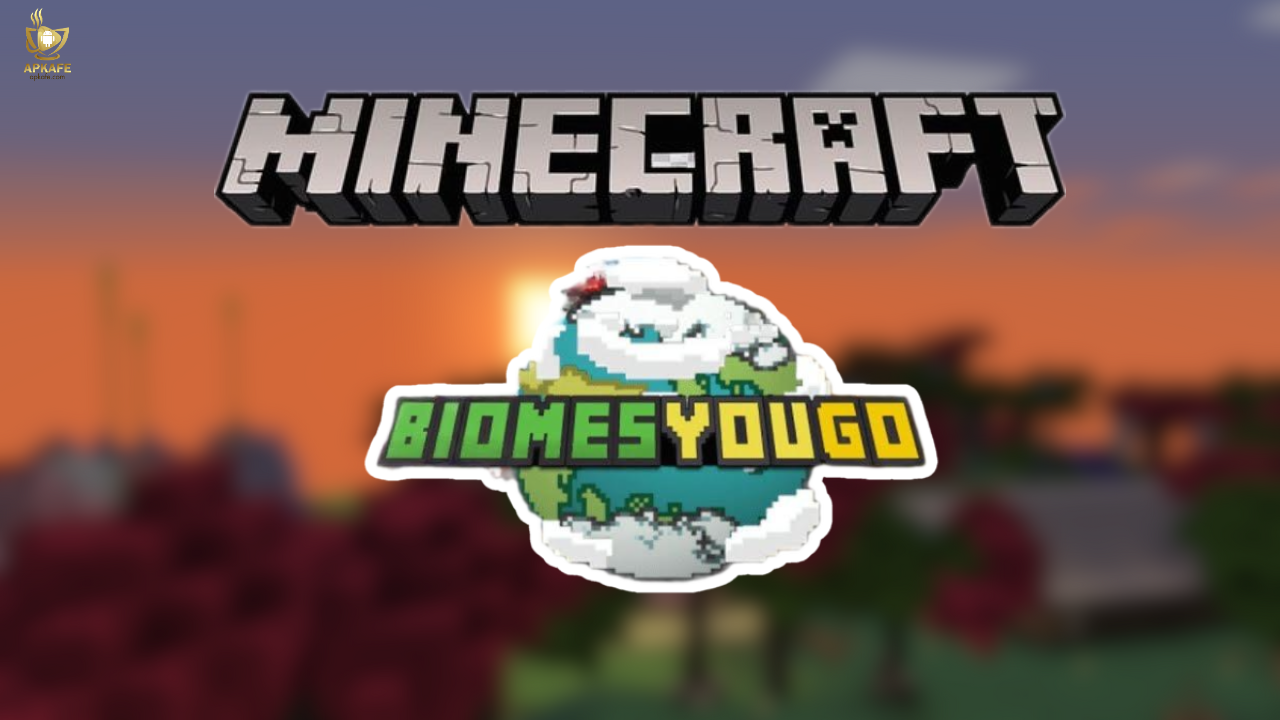Minecraft Biomes: Exploring the Game's Diverse Landscapes
Minecraft's biomes create a world filled with variety and challenges, from lush forests to dangerous Nether landscapes. Each biome offers unique terrain, resources, mobs, and opportunities for adventure. In this guide, we’ll answer how many biomes are in Minecraft, explain how to find biomes in Minecraft, and share tips for thriving in each one.
Highlights
- Discover the number of biomes in Minecraft and their unique features.
- Learn how to find and teleport to biomes in Minecraft.
- Explore tips for survival and resource collection in every biome.
What Are Minecraft Biomes?
Minecraft biomes are distinct environmental regions within the game that feature unique terrain, weather, vegetation, and mobs. These biomes create the diverse landscapes that players explore, from lush forests and sunny plains to icy tundras and barren deserts. Each biome offers specific resources, challenges, and opportunities, shaping the gameplay experience. With over 60 biomes across the Overworld, Nether, and End dimensions, Minecraft’s biomes encourage exploration, creativity, and survival strategies, making every adventure unique and immersive.
Categories of Minecraft Biomes
Overworld Biomes
- Forest Biomes:
- Types: Standard Forest, Birch Forest, Dark Forest, Flower Forest.
- Features: Dense trees, flowers, and passive mobs like cows, pigs, and sheep.
- Unique Resources: Oak and birch wood, flowers for dyes.
- Plains Biomes:
- Features: Flat grasslands ideal for building and farming.
- Structures: Villages often generate here.
- Mobs: Horses and bees.
- Desert Biomes:
- Features: Sandy terrain with cacti, dead bushes, and occasional oases.
- Structures: Desert temples and villages.
- Challenges: Lack of water and vegetation, frequent hostile mobs.
- Mountain Biomes:
- Features: Steep terrain with high peaks and exposed stone.
- Resources: Emeralds and ores like coal and iron.
- Mobs: Goats and hostile mobs in caves.
- Snowy Biomes:
- Types: Snowy Tundra, Ice Spikes, Frozen River.
- Features: Snow-covered terrain, frozen water, and igloos.
- Mobs: Polar bears, rabbits, and strays (hostile skeleton variant).
- Jungle Biomes:
- Features: Tall jungle trees, bamboo, and vines.
- Unique Resources: Cocoa beans, bamboo, and melons.
- Mobs: Pandas, parrots, and ocelots.
- Swamp Biomes:
- Features: Marshy areas with water, lily pads, and vines.
- Mobs: Slimes and frogs.
- Unique Resources: Clay and blue orchids.
- Savanna Biomes:
- Features: Acacia trees and dry grasslands.
- Structures: Villages with unique designs.
- Mobs: Horses and llamas.
Ocean Biomes
- Warm Ocean:
- Features: Coral reefs, tropical fish, and sea pickles.
- Resources: Coral blocks and kelp.
- Deep Ocean:
- Features: Dark, deep water with ocean monuments and guardians.
- Challenges: Low visibility and hostile mobs like drowned.
- Frozen Ocean:
- Features: Icebergs, frozen water, and polar bears.
- Resources: Packed ice and blue ice.
- Lukewarm Ocean:
- Features: Moderate temperatures with sea grass and cod.
- Mobs: Dolphins and turtles.
Nether Biomes
- Nether Wastes:
- Features: Classic Nether terrain with lava lakes and netherrack.
- Resources: Quartz ore and gold nuggets.
- Mobs: Ghasts, piglins, and magma cubes.
- Crimson Forest:
- Features: Red-hued forests with crimson nylium and fungus.
- Resources: Crimson wood, weeping vines.
- Mobs: Hoglins and piglins.
- Warped Forest:
- Features: Blue-green forests, considered the safest Nether biome.
- Resources: Warped wood and nether sprouts.
- Mobs: Endermen.
- Basalt Deltas:
- Features: Chaotic terrain of basalt, blackstone, and magma blocks.
- Challenges: Frequent magma cube spawns.
- Soul Sand Valley:
- Features: Filled with soul sand and soul soil.
- Mobs: Ghasts and skeletons.
- Unique Effect: Soul sand slows movement.
End Biomes
- The End:
- Features: Void-filled terrain with obsidian pillars and the Ender Dragon.
- Mobs: Endermen.
- End Highlands:
- Features: Rolling terrain with End cities and End ships.
- Resources: Shulker shells and elytra.
- End Barrens:
- Features: Sparse terrain with little vegetation.
- Purpose: Transition biome between other End areas.
Rare and Unique Biomes
- Mushroom Fields:
- Features: Mycelium ground and giant mushrooms.
- Mobs: Mooshrooms (passive cows).
- Badlands (Mesa):
- Features: Clay-rich terrain with vibrant colors.
- Resources: Gold and terracotta.
- Modified Jungle Edge:
- Rarity: The rarest biome in Minecraft.
- Features: Transition area between jungles and other biomes.
How to Find Biomes in Minecraft
– Exploring Biomes Manually
- On Foot:
- Traverse the Minecraft world by walking, sprinting, or jumping to uncover nearby biomes.
- Pay attention to natural transitions, such as forests leading into plains or deserts.
- By Boat: Use boats to explore water biomes and their edges, such as oceans, rivers, and swamp borders.
- With Elytra: In the later stages of the game, use an Elytra to fly over large areas and quickly discover new biomes.
– Using Commands to Locate Biomes
- Locate Biomes:
- Use the /locate biome [biome_name] command to find the coordinates of a specific biome.
Example: /locate biome minecraft:desert
- The command will display the nearest biome of that type, along with its coordinates.
- Teleporting to Biomes:
Once you have the coordinates, use the /tp command to teleport directly to the biome: /tp [player_name] [x] [y] [z]
– Biome Finder Tools
- Online Biome Locators: Tools like Chunkbase Biome Finder allow players to input their world seed and view a map of biomes.
- How It Works:
- Enter your world seed into the tool.
- The map will display the location of each biome in your world.
- Uses: Perfect for players who want to plan exploration or locate specific biomes before starting.
– Mods for Finding Biomes
- Popular Mods: Mods like “Nature’s Compass” allow players to search for biomes directly in-game.
- How to Use Nature’s Compass:
- Craft the compass using wood, saplings, and iron.
- Select a biome to locate, and it will guide you to the nearest one.
– Minecraft Exploration Strategies
- Follow Rivers: Rivers often act as natural guides to different biomes.
- Search in Climate Zones:
- Minecraft biomes tend to cluster by climate. For example:
- Deserts, savannas, and badlands are warm biomes often found near each other.
- Forests, plains, and taigas are moderate biomes commonly found together.
- Minecraft biomes tend to cluster by climate. For example:
- Ocean Exploration: Oceans often border land biomes, providing a mix of resources and exploration paths.
– How Many Biomes Are in Minecraft?
- Overworld: Over 50 biomes, including forests, deserts, plains, and more.
- Nether: 5 biomes, including Nether Wastes, Crimson Forest, and Basalt Deltas.
- End: 3 biomes, including The End, End Highlands, and End Barrens.
– Why Find Biomes in Minecraft?
- Unique Resources:
- Some biomes have exclusive resources, such as bamboo in jungles or coral in warm oceans.
- Structures:
- Villages, temples, and igloos are biome-specific structures that offer loot and resources.
- Mobs:
- Certain mobs spawn only in specific biomes, such as pandas in jungles or polar bears in icy areas.
Tips for Surviving in Each Biome
Forest Biomes
- Challenges: Dense trees can obscure vision, making it harder to spot mobs or navigate.
- Survival Tips:
- Use the abundance of wood to craft tools, shelter, and fuel.
- Hunt passive mobs like sheep, pigs, and chickens for food.
- Create torches to illuminate dark areas and prevent hostile mob spawns.
Plains Biomes
- Challenges: Flat terrain makes it easy for hostile mobs to approach.
- Survival Tips:
- Build farms for food and resources due to open space and fertile land.
- Tame horses for faster travel.
- Use villages for trading and as a base of operations.
Desert Biomes
- Challenges:
- Lack of water and vegetation can make it hard to find food.
- High spawn rate of hostile mobs at night.
- Survival Tips:
- Search for desert temples and villages for loot and resources.
- Carry food and water (from other biomes) to sustain long explorations.
- Use cacti for defense or crafting green dye.
Snowy Biomes
- Challenges:
- Cold environment lacks crops and livestock.
- Limited visibility during snowstorms.
- Survival Tips:
- Find igloos for shelter and loot.
- Wear leather armor to avoid freezing effects (if added in mods).
- Hunt polar bears and rabbits for food.
Mountain Biomes
- Challenges:
- Difficult to navigate due to steep terrain.
- High altitudes can cause falls and damage.
- Survival Tips:
- Use scaffolding or ladders for safe climbing.
- Mine exposed ore veins like coal and emeralds.
- Build bridges or paths for easier traversal.
Ocean Biomes
- Challenges:
- Limited land for shelter.
- Hostile mobs like drowned can pose a threat.
- Survival Tips:
- Use doors or magma blocks to create air pockets for underwater exploration.
- Collect resources like kelp, coral, and fish for food and building materials.
- Search for shipwrecks and ocean ruins for treasure.
Jungle Biomes
- Challenges:
- Thick vegetation makes it easy to get lost.
- High spawn rate of hostile mobs in the shade.
- Survival Tips:
- Use vines for climbing and navigation.
- Collect cocoa beans and melons for food.
- Tame parrots and ocelots for companionship and utility.
Swamp Biomes
- Challenges:
- Difficult terrain with waterlogged areas.
- Slimes spawn at night, posing a threat.
- Survival Tips:
- Gather clay and lily pads for crafting and decoration.
- Use the abundant water for fishing and farming.
- Collect blue orchids for dyes.
Nether Biomes
- Challenges:
- High danger from lava, hostile mobs, and poor visibility.
- Survival Tips:
- Wear gold armor to avoid piglin aggression.
- Carry fire resistance potions to survive lava.
- Mine quartz and gold for valuable resources.
End Biomes
- Challenges:
- Sparse terrain with limited resources.
- Hostile Endermen and the Ender Dragon.
- Survival Tips:
- Bring plenty of ender pearls for safe navigation.
- Use a pumpkin on your head to prevent Endermen attacks.
- Explore End cities for elytras and shulker shells.
Rare Biomes and Fun Facts in Minecraft
Rare Biomes
– Modified Jungle Edge
- Rarity: The rarest biome in Minecraft, found only where jungle and swamp biomes meet.
- Features: Dense vegetation, tall jungle trees, and unique terrain transitions.
- Fun Fact: The chances of finding this biome naturally are less than 0.0001%.
– Bamboo Jungle
- Rarity: A sub-biome of the jungle, featuring dense bamboo growth.
- Features: Pandas spawn here exclusively.
- Fun Fact: Bamboo jungles are the perfect location for building Asian-themed structures.
– Mushroom Fields
- Rarity: A rare and peaceful biome typically found as an isolated island.
- Features:
- Covered with mycelium and giant mushrooms.
- Exclusive mobs: Mooshrooms.
- Fun Fact: Hostile mobs cannot spawn here, making it a safe haven for players.
– Badlands (Mesa)
- Rarity: A dry, colorful biome with layers of terracotta and red sand.
- Features: Abundant gold ore near the surface.
- Fun Fact: Abandoned mineshafts are more common here than in other biomes.
– Ice Spikes Biome
- Rarity: A rare variant of the snowy tundra biome.
- Features:
- Tall, pointed ice structures known as “ice spikes.”
- Packed ice is abundant.
- Fun Fact: Ice spikes can be used to build stunning, frosty-themed bases.
– Eroded Badlands
- Rarity: A sub-biome of the Badlands featuring steep, eroded cliffs.
- Features: Unique terrain with towering spires and colorful layers.
- Fun Fact: This biome resembles natural canyon landscapes in real life.
Fun Facts About Biomes
– Biome-Specific Advancements: Achievements like “Hot Tourist Destinations” require visiting all five Nether biomes.
– Largest Biome by Area: Oceans typically cover the most surface area in Minecraft worlds.
– Color Variations: Grass, water, and foliage colors change based on the biome, creating visually distinct environments.
– Unspawnable Areas: Mushroom Fields are one of the only biomes where hostile mobs cannot spawn naturally.
– Emerald Ore Exclusivity: Emerald ore spawns only in mountain biomes, making it a biome-specific resource.
– Strange Origins of the Creeper: The creeper, one of Minecraft’s iconic mobs, was accidentally created while coding the pig model.
Conclusion
Minecraft biomes are the foundation of the game’s rich and diverse world, offering players unique environments to explore, resources to gather, and challenges to overcome. From lush Overworld forests to the fiery landscapes of the Nether and the mysterious End, each biome enhances your gameplay experience. Whether you’re building, surviving, or adventuring, understanding biomes unlocks new possibilities and creativity in your Minecraft journey.
Ready to explore the vast and varied world of Minecraft biomes? Download Minecraft today and embark on an unforgettable adventure across forests, deserts, oceans, and beyond. For expert tips, in-depth guides, and creative ideas, follow APKAFE. Discover every biome and make your mark on the Minecraft universe—start exploring now!
User Reviews














